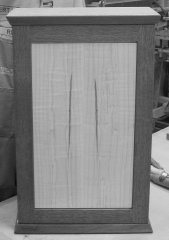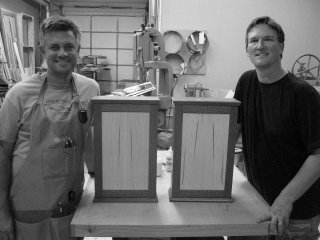The first iteration of the class “Make a Wall-Hung Cabinet” (henceforth to be called simply “Cabinetmaking”) was held over three days in late August (26-28) 2011 with two students: Matt Vredenburg and Chip Hidinger, both woodworkers with some experience. It was a very busy three days, but in the end I think we arrived about where I had hoped we would, and both students went home with cabinets they can be proud of.
The cabinet we made was small (50cm x 30cm x 15cm), a simple design based on the kind of work done at the College of the Redwoods. Built of Honduras mahogany and curly soft maple, the carcase is doweled and the back is a full frame-&-panel construction glued into a rabbet. The door overlays the front of the cabinet completely and is hung on 7mm (5/16″) brass knife hinges. The door frame is slip mortise-&-tenon, and the panel is installed as would be a piece of glass — so it is removable. Up to two adjustable mahogany shelves can be placed in the interior of the cabinet. The top and bottom edge profiles are worked completely by hand, with planes and spokeshaves, and all surfaces are hand planed and lightly sanded (400-600 grit paper). The finish is shellac polish, hand-applied prior to assembly.
Considering it would take an experienced maker several days to make this cabinet (while honoring the construction methods, attention to craftsmanship and detail work), asking less experienced makers to do all the work in three days is biting off a lot. There’s simply no way we could start from scratch and hope to get anywhere close to completion, so I milled all the parts and did the mortise-&-tenon joinery in advance. The students did the case joinery and all the hand work of fitting the frame and panel joinery, planing and finishing all the surfaces, designing and working the top and bottom edge profiles, assembling the case and fitting and hanging the door. At the end of the session we issued a collective “Whew!” There’s much more to this kind of work than meets the eye, and much of the detail work comes at the end when everything is assembled and fitted.
Check out the image gallery from the class (below), and look for this class to be offered again in the next course rounds.
































One Response to Cabinetmaking Class